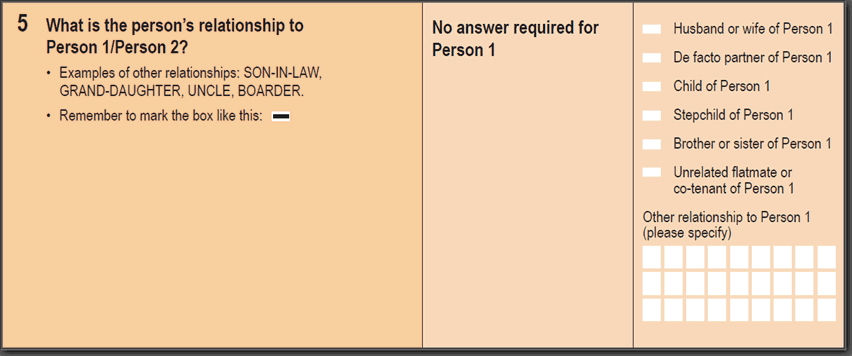Child Type (CTPP)
This variable records the different parent-child relationships within families. It is applicable to all persons in family households who are identified as being a child.
How this variable is created
In the Census, data on child/parent relationships within a dwelling is mainly derived from the Relationship in Household question on the Census Household Form, which asks for each person’s relationship to Person 1 on the form. An image of this question is provided below.
All persons aged under 15 years are regarded as children. Persons aged over 15 years are only regarded as children if they are living with a natural, adoptive, step, foster or grandparent.
Children are classified as an 'Otherwise related child' when they live with another adult relative (e.g. older sibling, aunt, uncle), but no natural, adoptive, step-, foster- or grand- parent is identified within the dwelling. Children are classified as 'Unrelated child' when no relative is identified within the same dwelling.
In some cases, children are listed on the Census Household Form as Person 2. In this case, if both parents are usual residents, the response 'Child of both Person 1 and Person 2' is not available in the relationship question (question 5) for Person 2. Coders attempt to establish whether the child was a step child or child of both parents using other information such as surname.
Variable history
A question on the relationships between members of a household has been asked in all censuses since 1911, and a variable about the type of child or offspring has been output since 1991. No changes were made for 2016.
Non-response rate
Non-response rate only applies to data items that directly reflect responses to individual Census form questions. Child Type does not have a non-response rate as it is a derived value created during Census processing for applicable persons. For more information, refer to Understanding Census data quality.
Data usage notes
Priority is given to identifying those relationships which form a ‘family nucleus’, i.e. partnerships and parent/child relationships and for many households, identifying relationships to assist the coding of family or household structure for that dwelling is quite straightforward. However, across the community, a wide variety of living arrangements exists and family structures can be complex and dynamic in nature, and so the quality of family data in the Census is partly dependent on people’s ability to describe these relationships within the constraints of the generalised questionnaire format required by a Census. This is particularly the case for those dwellings containing blended families or multiple generations of a family.
Further information
A definition for Child Type is available in the 2016 Census Dictionary.
For more information on the related data item, see Relationship in Household.
Household form question image
Question 5 as it appeared on the 2016 Census Household Paper Form:

A text only version of the online Census Household form paper is available from the Downloads tab.
 Print Page
Print Page
 Print All
Print All